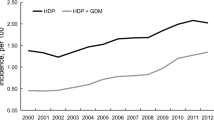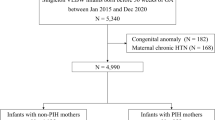Abstract
Objective
To examine the association of any type of maternal hypertensive disorders of pregnancy (HDP) and neonatal congenital heart diseases (CHD).
Study design
We compared the prevalence of CHD between neonates born to mothers with HDP to those delivered to mothers without HDP among 24,525,889 hospital records of living infants, from a national database. We controlled for multiple confounding factors by using multiple logistic regression analysis.
Results
Infants delivered to mothers with HDP had higher prevalence of CHD compared to infants born to mothers without HDP [5.20% vs. 1.47%; aOR: 2.51(2.38–2.64), p < 0.001]. Maternal diabetes was more frequent among infants born to mothers with HDP and was independently associated with CHD [aOR 5.14 (5.04–5.23), p < 0.001].
Conclusion
Infants born to mothers with hypertension had almost a threefold increase in CHD compared with those born to mothers without hypertension. Further studies are needed to investigate the underlying mechanism and direction of this association.
This is a preview of subscription content, access via your institution
Access options
Subscribe to this journal
Receive 12 print issues and online access
$259.00 per year
only $21.58 per issue
Buy this article
- Purchase on Springer Link
- Instant access to full article PDF
Prices may be subject to local taxes which are calculated during checkout
Similar content being viewed by others
References
ACOG Practice Bulletin No. 202: Gestational hypertension and preeclampsia. Obstet Gynecol. 2019;133:e1–25.
Lo JO, Mission JF, Caughey AB. Hypertensive disease of pregnancy and maternal mortality. Curr Opin Obstet Gynecol. 2013;25:124–32.
Donofrio MT, Moon-Grady AJ, Hornberger LK, Copel JA, Sklansky MS, Abuhamad A, et al. American Heart Association Adults With Congenital Heart Disease Joint Committee of the Council on cardiovascular disease in the young and council on clinical cardiology, council on cardiovascular surgery and anesthesia, and council on cardiovascular and stroke nursing. Diagnosis and treatment of fetal cardiac disease: a scientific statement from the American Heart Association. Circulation. 2014;129:2183–242.
Boyd HA, Basit S, Behrens I, Leirgul E, Bundgaard H, Wohlfahrt J, et al. Association between fetal congenital heart defects and maternal risk of hypertensive disorders of pregnancy in the same pregnancy and across pregnancies. Circulation. 2017;136:39–48.
Auger N, Fraser WD, Healy-Profitós J, Arbour L. Association between preeclampsia and congenital heart defects. JAMA. 2015;314:1588–98.
Brodwall K, Leirgul E, Greve G, Vollset SE, Holmstrøm H, Tell GS, et al. Possible common aetiology behind maternal preeclampsia and congenital heart defects in the child: a cardiovascular diseases in Norway project study. Paediatr Perinat Epidemiol. 2016;30:76–85.
Leslie K, Whitley GS, Herse F, Dechend R, Ashton SV, Laing K, et al. Increased apoptosis, altered oxygen signaling, and antioxidant defenses in first-trimester pregnancies with high-resistance uterine artery blood flow. Am J Pathol. 2015;185:2731–41.
Hayes Ryan D, McCarthy FP, O’Donoghue K, Kenny LC. Placental growth factor: a review of literature and future applications. Pregnancy Hypertens. 2018;14:260–4.
Llurba Olive E, Xiao E, Natale DR, Fisher SA. Oxygen and lack of oxygen in fetal and placental development, feto-placental coupling, and congenital heart defects. Birth Defects Res. 2018;110:1517–30.
Shi H, O’Reilly VC, Moreau JL, Bewes TR, Yam MX, Chapman BE, et al. Gestational stress induces the unfolded protein response, resulting in heart defects. Development. 2016;143:2561–72.
Llurba E, Sánchez O, Ferrer Q, Nicolaides KH, Ruíz A, Domínguez C, et al. Maternal and foetal angiogenic imbalance in congenital heart defects. Eur Heart J. 2014;35:701–7.
Ruiz A, Cruz-Lemini M, Masoller N, Sanz-Cortés M, Ferrer Q, Ribera I, et al. Longitudinal changes in fetal biometry and cerebroplacental hemodynamics in fetuses with congenital heart disease. Ultrasound Obstet Gynecol. 2017;49:379–86.
Ruiz A, Ferrer Q, Sánchez O, Ribera I, Arévalo S, Alomar O, et al. Placenta-related complications in women carrying a foetus with congenital heart disease. J Matern Fetal Neonatal Med. 2016;29:3271–5.
Ye Z, Su Q, Li L, Letter by Ye. et al. Regarding article, “association between fetal congenital heart defects and maternal risk of hypertensive disorders of pregnancy in the same pregnancy and across pregnancies”. Circulation. 2018;137:95–6.
HCUP Databases. Healthcare Cost and Utilization Project (HCUP). September 2019. Agency for Healthcare Research and Quality, Rockville, MD. https://www.hcup-us.ahrq.gov/kidoverview.jsp. Accessed 18 Dec 2019.
American Institute of Ultrasound in Medicine. AIUM practice guideline for the performance of fetal echocardiography. J Ultrasound Med. 2013;32:1067–82.
Van Gelder MM, Van Bennekom CM, Louik C, Werler MM, Roeleveld N, Mitchell AA. Maternal hypertensive disorders, antihypertensive medication use, and the risk of birth defects: a case-control study. BJOG. 2015;122:1002–9.
Grossfeld P, Nie S, Lin L, Wang L, Anderson RH. Hypoplastic Left Heart Syndrome: A New Paradigm for an Old Disease? J Cardiovasc Dev Dis. 2019;6:E10.
Crucean A, Alqahtani A, Barron DJ, Brawn WJ, Richardson RV, O’Sullivan J, et al. Re-evaluation of hypoplastic left heart syndrome from a developmental and morphological perspective. Orphanet J Rare Dis. 2017;12:138.
Arcelli D, Farina A, Cappuzzello C, Bresin A, De Sanctis P, Perolo A, et al. Identification of circulating placental mRNA in maternal blood of pregnancies affected with fetal congenital heart diseases at the second trimester of pregnancy: implications for early molecular screening. Prenat Diagn. 2010;30:229–34.
Dobierzewska A, Palominos M, Irarrazabal CE, Sanchez M, Lozano M, Perez-Sepulveda A, et al. NFAT5 is up-regulated by hypoxia: possible implications in preeclampsia and intrauterine growth restriction. Biol Reprod. 2015;93:14.
Lisowski LA, Verheijen PM, Copel JA, Kleinman CS, Wassink S, Visser GH, et al. Congenital heart disease in pregnancies complicated by maternal diabetes mellitus. An international clinical collaboration, literature review, and meta-analysis. Herz. 2010;35:19–26.
Balsells M, García-Patterson A, Gich I, Corcoy R. Major congenital malformations in women with gestational diabetes mellitus: a systematic review and meta-analysis. Diabetes Metab Res Rev. 2012;28:252–7.
Inversetti A, Fesslova V, Deprest J, Candiani M, Giorgione V, Cavoretto P. Prenatal growth in fetuses with isolated cyanotic and non-cyanotic congenital heart defects. Fetal Diagn Ther. 2018. https://doi.org/10.1159/000493938.
Hutcheon JA, Lisonkova S, Joseph KS. Epidemiology of pre-eclampsia and the other hypertensive disorders of pregnancy. Best Pract Res Clin Obstet Gynaecol. 2011;25:391–403.
MacDorman MF, Kirmeyer S. Fetal and perinatal mortality, United States, 2005. Natl Vital Stat Rep. 2009;57:1–19.
Divanovic A, Bowers K, Michelfelder E, Jaekle R, Newman T, Marcotte M, et al. Intrauterine fetal demise after prenatal diagnosis of congenital heart disease: assessment of risk. Prenat Diagn. 2016;36:142–7.
Lytzen R, Vejlstrup N, Bjerre J, Petersen OB, Leenskjold S, Dodd JK, et al. Live-born major congenital heart disease in Denmark: incidence, detection rate, and termination of pregnancy rate from 1996 to 2013. JAMA Cardiol. 2018;3:829–37.
Mai CT, Isenburg JL, Canfield MA, Meyer RE, Correa A, Alverson CJ, et al. National birth defects prevention network. National population-based estimates for major birth defects, 2010–4. Birth Defects Res. 2019;111:1420–35.
Urquia ML, Glazier RH, Gagnon AJ, Mortensen LH, Nybo Andersen AM, Janevic T, et al. ROAM Collaboration. Disparities in pre-eclampsia and eclampsia among immigrant women giving birth in six industrialised countries. BJOG. 2014;121:1492–500.
Iacobelli S, Bonsante F, Robillard PY. Pre-eclampsia and preterm birth in Reunion Island: a 13 years cohort-based study. Comparison with international data. J Matern Fetal Neonatal Med. 2016;29:3035–40.
Thilaganathan B. Preeclampsia and fetal congenital heart defects: spurious association or maternal confounding? Circulation. 2017;136:49–51.
Courtney JA, Cnota JF, Jones HN. The role of abnormal placentation in congenital heart disease; cause, correlate, or consequence? Front Physiol. 2018;9:1045.
Llurba E, Syngelaki A, Sánchez O, Carreras E, Cabero L, Nicolaides KH. Maternal serum placental growth factor at 11–13 weeks’ gestation and fetal cardiac defects. Ultrasound Obstet Gynecol. 2013;42:169–74.
Perez-Garcia V, Fineberg E, Wilson R, Murray A, Mazzeo CI, Tudor C, et al. Placentation defects are highly prevalent in embryonic lethal mouse mutants. Nature. 2018;555:463–8.
Watson ED, Cross JC. Development of structures and transport functions in the mouse placenta. Physiology. 2005;20:180–93.
Mayer-Pickel K, Kolovetsiou-Kreiner V, Stern C, Münzker J, Eberhard K, Trajanoski S, et al. Effect of low-dose aspirin on soluble FMS-like tyrosine kinase 1/placental growth factor (sFlt-1/PlGF ratio) in pregnancies at high risk for the development of preeclampsia. J Clin Med. 2019;8:E1429.
Panagodage S, Yong HE, Da Silva Costa F, Borg AJ, Kalionis B, Brennecke SP, et al. Low-dose acetylsalicylic acid treatment modulates the production of cytokines and improves trophoblast function in an in vitro model of early-onset preeclampsia. Am J Pathol. 2016;186:3217–24.
Su MT, Wang CY, Tsai PY, Chen TY, Tsai HL, Kuo PL. Aspirin enhances trophoblast invasion and represses soluble fms-like tyrosine kinase 1 production: a putative mechanism for preventing preeclampsia. J Hypertens. 2019;37:2461–9.
Psoter KJ, Rosenfeld M. Opportunities and pitfalls of registry data for clinical research. Paediatr Respir Rev. 2013;14:141–5.
Author information
Authors and Affiliations
Corresponding author
Ethics declarations
Conflict of interest
The authors declare that they have no conflict of interest.
Additional information
Publisher’s note Springer Nature remains neutral with regard to jurisdictional claims in published maps and institutional affiliations.
Rights and permissions
About this article
Cite this article
Sanapo, L., Donofrio, M.T., Ahmadzia, H.K. et al. The association of maternal hypertensive disorders with neonatal congenital heart disease: analysis of a United States cohort. J Perinatol 40, 1617–1624 (2020). https://doi.org/10.1038/s41372-020-00795-9
Received:
Revised:
Accepted:
Published:
Issue Date:
DOI: https://doi.org/10.1038/s41372-020-00795-9



